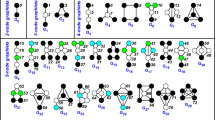Abstract
To probe network characteristics, two predominant ways of network comparison are global property statistics and subgraph enumeration. However, they suffer from limited information and exhaustible computing. Here, we present an approach to compare networks from the perspective of data analysis. Initially, the approach projects each node of original network as a high-dimensional data point, and the network is seen as clouds of data points. Then the dispersion information of the principal component analysis (PCA) projection of the generated data clouds can be used to distinguish networks. We applied this node projection method to the yeast protein-protein interaction networks and the Internet Autonomous System networks, two types of networks with several similar higher properties. The method can efficiently distinguish one from the other. The identical result of different datasets from independent sources also indicated that the method is a robust and universal framework.
Access this chapter
Tax calculation will be finalised at checkout
Purchases are for personal use only
Preview
Unable to display preview. Download preview PDF.
Similar content being viewed by others
References
Watts, D.J., Strogatz, S.H.: Collective Dynamics of ’Small-World’ Networks. Nature (London) 393, 440–442 (1998)
Barabási, A.L., Albert, R.: Emergence of Scaling in Random Networks. Science 286, 509–512 (1999)
Newman, M.E.J.: The Structure and Function of Complex Networks. SIAM Rev. 45, 167–256 (2003)
Boccaletti, S., Latora, V., Moreno, Y., Chavez, M., Hwang, D.U.: Complex Networks: Structure and Dynamics. Phys. Rep. 424, 175–308 (2006)
Costa, L., Da, F., Rodrigues, F.A., Travieso, G., Villas Boas, P.R.: Characterization of Complex Networks: a Survey of Measurements. Adv. Phys. 56, 167–242 (2007)
Amaral, L.A.N., Scala, A., Barthélémy, M., Stanley, H.E.: Classes of Small-World Networks. Proc. Natl. Acad. Sci. U.S.A 97, 11149–11152 (2000)
Pržulj, N.: Biological Network Comparison Using Graphlet Degree Distribution. Bioinformatics 23, 177–183 (2006)
Goh, K., Oh, E., Jeong, H., Kahng, B., Kim, D.: Classification of Scale-Free Networks. Proc. Natl. Acad. Sci. U.S.A 99, 12583–12588 (2002)
Newman, M.E.J., Park, J.: Why Social Networks are Different from Other Types of Networks. Phys. Rev. E 68, 036122 (2003)
Milo, R., Itzkovitz, S., Kashtan, N., Levitt, R., Shen-Orr, S., Ayzenshtat, I., Sheffer, M., Alon, U.: Superfamilies of Evolved and Designed Networks. Science 303, 1538–1542 (2004)
Middendorf, M., Ziv, E., Wiggins, C.H.: Inferring Network Mechanisms: The Drosophila Melanogaster Protein Interaction Network. Proc. Natl. Acad. Sci. U.S.A 102, 3192–3197 (2005)
Guimerà, R., Sales-Pardo, M., Amaral, L.A.N.: Classes of Complex Networks Defined by Role-to-Role Connectivity Profiles. Nature Phys. 3, 63–69 (2007)
McAuley, J.J., Costa, L.D.F., Caetano, T.S.: Rich-Club Phenomenon across Complex Network Hierarchies. Appl. Phys. Lett. 91, 84103 (2007)
Mahadevan, P., Krioukov, D., Fall, K., Vahdat, A.: Systematic topology analysis and generation using degree corrlation. In: SIGCOMM (2006)
Johnson, R.A., Wichern, D.W.: Applied Multivariate Statistical Analysis. Prentice-Hall, Englewood Cliffs (1998)
Maslov, S., Sneppen, K.: Specificity and Stability in Topology of Protein Networks. Science 296, 910–913 (2002)
Leicht, E.A., Holme, P., Newman, M.E.J.: Vertex Similarity in Networks. Phys. Rev. E 73, 026120 (2006)
Golub, G.H., Van Loan, C.F.: Matrix Computations. Johns Hopkins University Press, Baltimore (1996)
The data YJ is from CCNR-Resources, http://www.nd.edu/~networks/resources.htm and others, YC, YI and YU are from CCSB Interactome Database, http://interactome.dfci.harvard.edu/S_cerevisiae/host.php
The Route Views Project, http://www.routeviews.org/ , UCLA Internet Research Lab, http://irl.cs.ucla.edu/topology/ and the DIMES project, http://www.netdimes.org/
Maslov, S., Sneppen, K., Zaliznyak, A.: Detection of Topological Patterns in Complex Networks: Correlation Profile of the Internet. Physica A 333, 529–540 (2004)
Park, J., Newman, M.E.J.: Origin of Degree Correlations in the Internet and Other Networks. Phys. Rev. E 68, 026112 (2003)
Author information
Authors and Affiliations
Editor information
Editors and Affiliations
Rights and permissions
Copyright information
© 2009 ICST Institute for Computer Science, Social Informatics and Telecommunications Engineering
About this paper
Cite this paper
Li, W., Yang, JY. (2009). Comparing Networks from a Data Analysis Perspective. In: Zhou, J. (eds) Complex Sciences. Complex 2009. Lecture Notes of the Institute for Computer Sciences, Social Informatics and Telecommunications Engineering, vol 5. Springer, Berlin, Heidelberg. https://doi.org/10.1007/978-3-642-02469-6_67
Download citation
DOI: https://doi.org/10.1007/978-3-642-02469-6_67
Publisher Name: Springer, Berlin, Heidelberg
Print ISBN: 978-3-642-02468-9
Online ISBN: 978-3-642-02469-6
eBook Packages: Computer ScienceComputer Science (R0)




